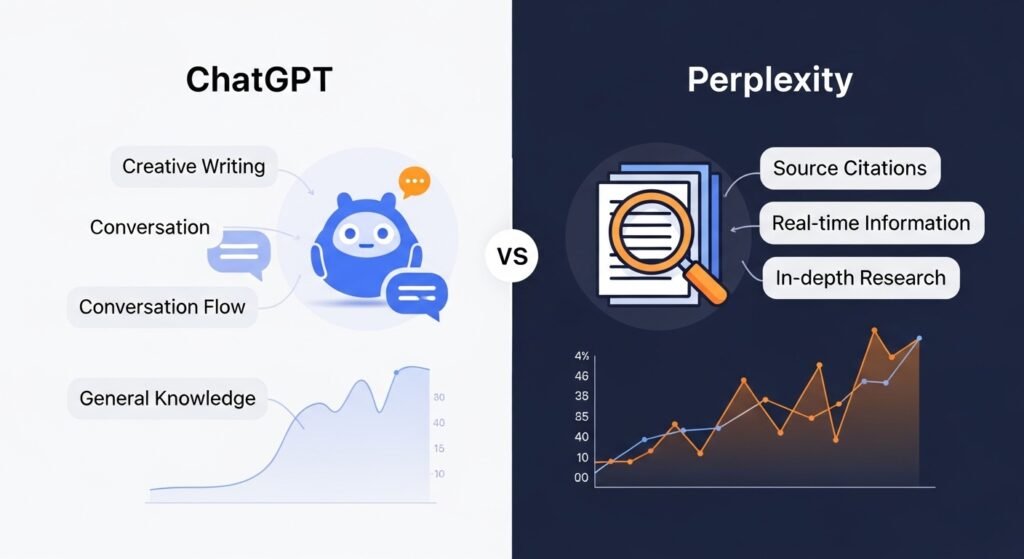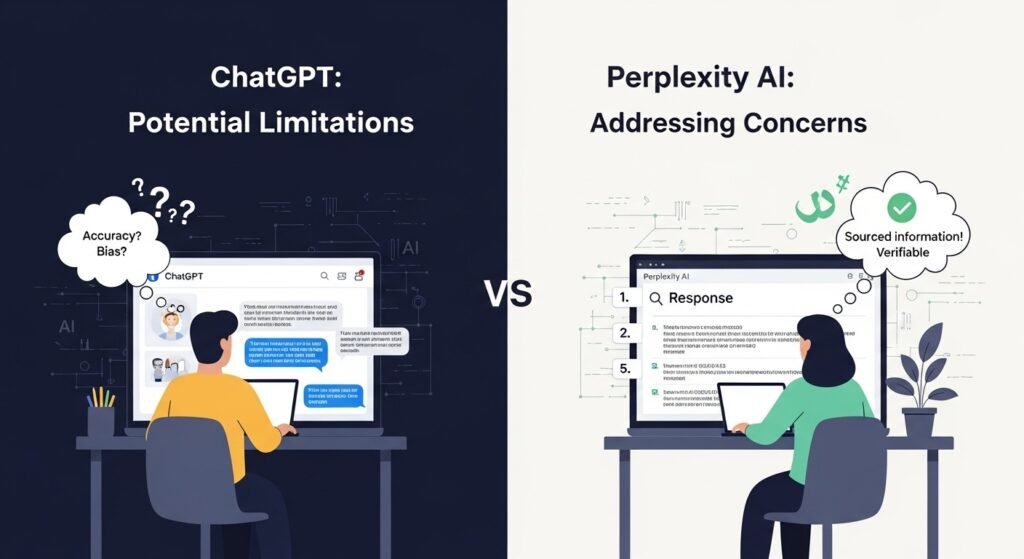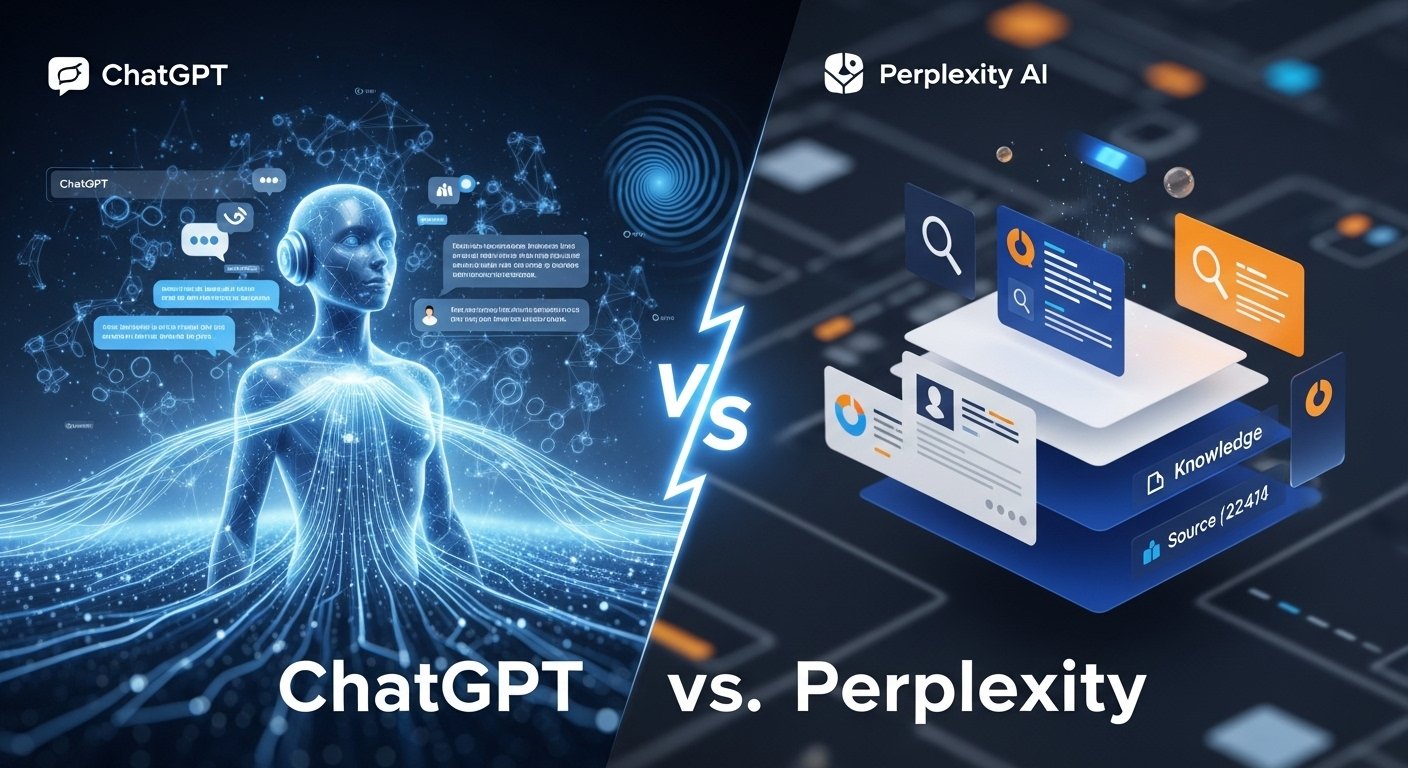In the fast-evolving world of artificial intelligence, ChatGPT and Perplexity AI stand out as powerful tools with distinct functionalities. As of August 2025, both have seen significant advancements, making it crucial to understand their differences to choose the right tool for your needs. This detailed comparison covers their features, use cases, and recent developments to provide a clear picture of how they differ.
Overview of ChatGPT
ChatGPT, developed by OpenAI, is a versatile language model designed for a wide range of text-based tasks. It excels in generating human-like text, answering questions, writing content, and assisting with coding. Its capabilities include:
- Answering diverse questions, from general knowledge to technical queries.
- Generating creative content, such as stories, essays, or marketing copy.
- Assisting with programming by writing or debugging code.
- Supporting multimodal inputs, including text, images, and audio.
However, ChatGPT’s responses are based on its training data, which may not include real-time information unless integrated with external tools like plugins or APIs. It does not automatically provide citations, though users can prompt it to include references.
Overview of Perplexity AI
Perplexity AI, launched in August 2022, is an AI-powered search engine that synthesizes real-time web search results to deliver concise, accurate answers. Unlike traditional search engines that list links, Perplexity provides direct responses with citations for transparency. Key features include:
- Real-time web search for up-to-date information.
- Citations for all answers, linking to original sources.
- Conversational follow-ups to maintain context during research.
- A new AI browser, Comet, launched in July 2025, enhancing search capabilities.
Perplexity AI is particularly popular among researchers, professionals, and students who need reliable, sourced information quickly. It has grown rapidly, with 15 million active monthly users and over 100 million weekly queries as of 2025.
To know the difference between Bard Vs ChatGPT read it out.
Detailed Comparison

The following table summarizes the key differences between ChatGPT and Perplexity AI based on their features and capabilities as of August 2025:
| Feature/Aspect | Perplexity AI | ChatGPT |
|---|---|---|
| Primary Focus | Delivers concise, factual answers with real-time citations, ideal for research. | Excels in conversational interactions, creative content, and coding. |
| Real-time Web Search | Incorporates real-time web search for current information. | Relies on training data; real-time data requires integrations. |
| Citations | Provides citations for all answers, ensuring transparency and verifiability. | Does not inherently provide citations; references need prompting. |
| Conversational Capability | Focused on search-related follow-ups, less suited for extended dialogue. | Designed for extended, back-and-forth conversations. |
| Multimodal Capabilities | Primarily text-based; Comet browser offers some advanced features. | Supports text, images, and audio inputs for versatile interactions. |
| Use Cases | Quick research, fact-checking, and sourced information retrieval. | Creative writing, coding, brainstorming, and general conversations. |
| Pricing | Free plan: unlimited quick searches, 5 Pro searches/day; Pro plan: $20/month. | Free version; ChatGPT Plus: $20/month for advanced features. |
| Advanced Models | Pro tier includes Deepseek R1, Claude 3.7 Sonnet, Sonar; Enterprise Pro: GPT-4. | Uses GPT-4 and other models, depending on subscription tier. |
| Limitations | Depends on source quality; limited multimodal functionality; legal concerns. | Limited real-time data; no automatic citations; potential for errors. |
Real-time Web Search
Perplexity AI’s core strength is its ability to access real-time web data, ensuring answers reflect the latest information available. For example, it can provide current weather updates or recent news with citations. ChatGPT, while powerful, relies on its training data, which may not include the most recent events unless paired with web access tools.
Citations and Source Verification
Perplexity AI automatically includes citations with hyperlinks to original sources, making it ideal for users who need to verify information. ChatGPT does not provide citations by default, though users can request references, which may not always be as precise or linked to specific sources.
Conversational Capabilities
Both tools support conversational interactions, but their approaches differ. Perplexity AI maintains context for search-related follow-ups, making it effective for in-depth research. ChatGPT is designed for extended, open-ended conversations, excelling in creative and casual dialogues.
Use Cases
Perplexity AI is best suited for:
- Researching academic topics with access to scholarly sources.
- Fact-checking with verifiable citations.
- Retrieving up-to-date information, such as financial data or news.
ChatGPT shines in:
- Writing creative content, like stories or marketing materials.
- Assisting with coding or debugging.
- Engaging in brainstorming sessions or casual conversations.
Multimodal Capabilities
ChatGPT supports multimodal inputs, allowing users to work with text, images, and audio. For instance, it can generate images via DALL-E or process audio inputs. Perplexity AI is primarily text-based, though its Comet browser, launched in July 2025, introduces features like image description and article summarization.
Pricing and Access
Perplexity AI offers a free plan with unlimited quick searches and five Pro searches per day. Its Pro plan, priced at $20/month, provides unlimited searches, access to advanced models, and additional features like file uploads. ChatGPT also offers a free version, with ChatGPT Plus at $20/month, providing access to GPT-4 and faster response times.
Recent Developments
As of August 2025, Perplexity AI has made significant strides:
- Comet Browser: Launched in July 2025, this Chromium-based browser integrates Perplexity’s search engine, enabling tasks like generating summaries and conducting research.
- Deep Research Feature: Introduced in February 2025, this feature delivers comprehensive reports in 2-4 minutes by analyzing hundreds of sources.
- User Growth: Perplexity has 15 million active monthly users, boosted by a partnership with Airtel in India, offering a year-long Pro subscription.
ChatGPT continues to lead in conversational AI, with ongoing updates to its models and integrations. It remains a versatile tool for creative and technical tasks, supported by OpenAI’s extensive API ecosystem.
Potential Limitations and Concerns

Perplexity AI faces challenges related to source quality and legal concerns over content scraping, with lawsuits from media organizations like The New York Times reported in 2024. Its conversational capabilities are also less robust than ChatGPT’s. ChatGPT, while versatile, may produce errors or outdated information without real-time web access and lacks automatic source verification.
Future Outlook
Both tools are poised for further advancements. Perplexity AI’s focus on real-time search and transparency positions it as a strong competitor to traditional search engines like Google. ChatGPT’s broad applicability ensures its relevance across creative and technical domains. As AI evolves, both tools are likely to integrate more advanced features, enhancing their utility in daily workflows.
Which Tool Should You Choose?
Your choice depends on your specific needs:
- Choose Perplexity AI if you prioritize real-time, sourced information for research or fact-checking. Its Deep Research feature and Comet browser make it a powerful tool for professionals and students.
- Choose ChatGPT if you need a versatile AI for creative writing, coding, or open-ended conversations. Its multimodal capabilities and conversational depth are ideal for diverse applications.
Conclusion
ChatGPT and Perplexity AI are both powerful AI tools, but they cater to different needs. Perplexity AI excels in providing accurate, real-time, and cited information, making it the go-to choice for research and fact-checking. ChatGPT, with its versatility and multimodal capabilities, is better suited for creative tasks, coding, and general conversations. By understanding these differences, you can select the tool that best aligns with your goals.
Understand the concept that ChatGPT does track you?
